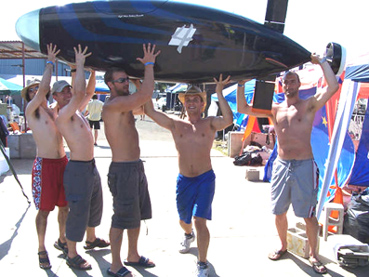Nouvelles
Submarine built by École Polytechnique de Montréal wins 1st place at the Human Powered Submarine Contest 2006 in California
An exceptional award for the Polytechnique team
The Archimède team, competing against eleven teams
from different universities across North America and Europe, stepped up to the podium no less than six times:
- 1st place in Overall Engineering
- 2nd place in Best Presentation
- 2nd place in Best Design
- 2nd place in Best Fabrication
- 2nd place in Innovation
- 2nd place in Fastest Submarine
A unique competition
With its emphasis on human power--which limits the size, cost and complexity of
the submarines--the HPS, organized biannually by the American Society of Mechanical Engineers, looks for ingenuity and
cleverness among the competitors who design and pilot the submarines.
The HPS also acts as a bridge between the university sector and industry, allowing participants to attract the attention of companies.
The competition takes place in a pool 80 m long and 15 m deep. The main goal is to reach the highest peak speed over a distance of 60 metres.
Gruelling physical preparation: pilot lost 43 lb.!
Archimède consists of a fibreglass shell 2 m long
and 44 cm wide, into which the pilot slides, armed with a bottle of oxygen, since the shell fills up with water when submerged.
By pedalling, the pilot turns the propeller which powers the engine. One of the technical advantages Archimède had over its
competitors was a high-performance propeller. Designed by Nautican Canada and built by Ecole Polytechnique's Department of
Mechanichal Engineering, it is specially adapted to the pedalling strength of the pilot. Thus, Archimède was able to reach a
speed of 4.534 knots during the race.
But the secret to Archimède's success lay as much in the top-notch physical shape of its team as in the ingenuity of its design. Marc-Antoine Brissette, Director of the Archimède technical group, lost 43 lb. in order to pilot the sub during the competition. "My shoulders were too wide to fit into the interior. So, for a number of months, I followed a training program put together by the Department of Kinesiology at Université de Montréal to lose weight and gain pedalling strength. Solid pedalling is key to picking up speed under water."
Archimède won't be gathering much dust in the months to come: the team has set itself the challenge of beating the record for speed at the next competition to be held in Washington, from June 25 to 30, 2007.

From left to right: Felix Chenier, Philippe Graveline,
Hugo Molinari, Leonidas Aubert, Marc-Antoine Brissette
For additional information: Archimède website



